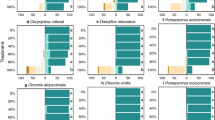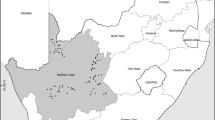Abstract
The resting eggs of large branchiopods do not hatch all at once during a hydroperiod; instead, a fraction of the eggs are left dormant to cope with unstable conditions in temporary wetlands. In order to maximize fitness, the fraction that terminates diapause is modified by signals indicating habitat suitability and biotic interactions. Here, in a laboratory experiment, we investigate the effect of conspecific cues on the hatching time and hatching rate of resting eggs from Triops cancriformis (Bosc, 1801). While hatching time was not significantly affected by conspecific cues, the effect of these cues on hatching rate was highly significant, with hatching rate increasing with increasing concentration of conspecific cues. This indicates that alongside environmental factors, conspecific cues also have the power to terminate the diapause of Triops resting eggs. In addition to indicating suitable conditions, such cues could also act as a mechanism for reducing egg cannibalism by adults, which are predominantly benthic feeders. As such, our results suggest that the response of large branchiopod encysted embryos to conspecific chemical cues could have evolved as a response to the feeding strategy of their adult stages; however, more research will be needed to fully understand the mechanism(s) behind this response.



Similar content being viewed by others
Data availability
All data generated or analysed during this study are included in the published article or in the supplementary information file. Data are included as electronic supplementary material (Online Resource 1).
Code availability
Not applicable.
References
Beladjal, L., K. Dierckens & J. Mertens, 2007. Pheromones inhibit the hatching of diapausing Anostraca (Crustacea: Branchiopoda). Animal Biology 57: 1–9.
Bishop, J. A., 1967. Some adaptations of Limnadia stanleyana King (Crustacea: Branchiopoda: Conchostraca) to a temporary freshwater environment. Journal of Animal Ecology 36: 599–609.
Boix, D., J. Sala & R. Moreno-Amich, 2002. Population dynamics of Triops cancriformis (Crustacea: Branchiopoda: Notostraca) of the Espolla temporary pond in the northeastern Iberian peninsula. Hydrobiologia 486: 175–183.
Boix, D., J. Sala, S. Gascon & S. Brucet, 2006. Predation in a temporary pond with special attention to the trophic role of Triops cancriformis (Crustacea: Branchiopoda: Notostraca). Hydrobiologia 571: 341–353.
Bozelli, R. L., M. Tonsi, F. Sandrini & M. Manca, 2008. A Big Bang or small bangs? Effects of biotic environment on hatching. Journal of Limnology 67: 100–106.
Brendonck, L., 1996. Diapause, quiescence, hatching requirements: what we can learn from large freshwater branchiopods (Crustacea: Branchiopoda: Anostraca, Notostraca, Conchostraca). Hydrobiologia 320: 85–97.
Brendonck, L. & L. De Meester, 2003. Egg banks in freshwater zooplankton: evolutionary and ecological archives in the sediment. Hydrobiologia 491: 65–84.
Brendonck, L., D. C. Rogers, J. Olesen, S. Weeks & W. R. Hoeh, 2008. Global diversity of large branchiopods (Crustacea: Branchiopoda) in freshwater. Hydrobiologia 595: 167–176.
Brtek, J., 2005. Fauna Slovenska. Anostraca, Notostraca, Spinicaudata, Laevicaudata (Crustacea: Branchiopoda). Slovakian Academic Press (VEDA), Bratislava.
Brtek, J. & A. Thiéry, 1995. The geographic distribution of the European branchiopods (Anostraca, Notostraca, Spinicaudata, Laevicaudata). Hydrobiologia 298: 263–280.
Eklund, A., 2016. beeswarm: The Bee Swarm Plot, an Alternative to Stripchart. R package version 0.2.3. https://CRAN.R-project.org/package=beeswarm.
Golzari, A., S. Khodabandeh & J. Seyfabadi, 2009. Some biological characteristics of tadpole shrimp, Triops cancriformis, from seasonal pools of west Azarbaijan (Iran). Journal of Agricultural Science and Technology 11: 81–90.
Gottwald, R. & W. Hödl, 1996. Zur Phänologie von Groß-Branchiopoden der unteren March-Auen. Stapfia 42: 51–57.
Hempel-Zawitkowska, J., 1967. Natural history of Triops cancriformis (Bosc). Zoologica Poloniae 17: 173–239.
Hempel-Zawitkowska, J., 1970. The influence of strong ultraviolet radiation on hatchability of Triops cancriformis (Bosc) eggs. Polskie Archiwum Hydrobiologii 17: 483–494.
Hempel-Zawitkowska, J., 1971. Resistance of eggs of Triops cancriformis (Bosc) to low temperatures as related to several chosen environmental factors. Polskie Archiwum Hydrobiologii 186: 295–302.
Hojsgaard, S., U. Halekoh & J. Yan, 2006. The R package geepack for generalized estimating equations. Journal of Statistical Software 15: 1–11.
Kuller, Z. & A. Gasith, 1996. Comparison of the hatching process of the tadpole shrimps Triops cancriformis and Lepidurus apus lubbocki (Notostraca) and its relation to their distribution in rain-pools in Israel. Hydrobiologia 335: 147–157.
La, G. H., H. G. Jeong, M. C. Kim, G. J. Joo, K. H. Chang & H.-W. Kim, 2009. Response of diapausing eggs hatching to changes in temperature and the presence of fish kairomones. Hydrobiologia 635: 399–402.
Lass, S., M. Vos, J. Wolinska & P. Spaak, 2005. Hatching with the enemy: Daphnia diapausing eggs hatch in the presence of fish kairomones. Chemoecology 15: 7–12.
Merta, L., V. Zavadil, & J. Sychra, 2016. Atlas rozšíření velkých lupenonožců České republiky. Agentura ochrany přírody a kra**y ČR, Praha.
Mitchell, S. A., 1990. Factors affecting the hatching of Streptocephalus macrourus Daday (Crustacea; Eubranchiopoda) eggs. Hydrobiologia 194: 13–22.
Møller, O. S., J. Olesen & J. T. Høeg, 2003. SEM studies on the early larval development of Triops cancriformis (Bosc) (Crustacea: Branchiopoda, Notostraca). Acta Zoologica 84: 267–284.
Murugan, G. & H. J. Dumont, 1995. Influence of light, DMSO and glycerol on the hatchability of Thamnocephalus platyurus Packard cysts. Hydrobiologia 298: 175–178.
Petrov, B. & D. M. Cvetković, 1996. Seasonal dynamics of Triops cancriformis (Bosc, 1801) (Crustacea, Branchiopoda) in the Banat province in Yugoslavia. Tiscia 30: 39–43.
Petrov, B. & I. Petrov, 1997. The status of Anostraca, Notostraca and Conchostraca (Crustacea: Branchiopoda) in Yugoslavia. Hydrobiologia 359: 29–35.
R Core Team, 2020. R: A language and environment for statistical computing. R Foundation for Statistical Computing, Vienna, Austria. https://www.R-project.org/.
Robinson, D., A. Hayes, & S. Couch, 2021. broom: Convert Statistical Objects into Tidy Tibbles. R package version 0.7.4. https://CRAN.R-project.org/package=broom.
Rogers, D. C., 2014. Larger hatching fractions in avian dispersed anostracan eggs (Branchiopoda). Journal of Crustacean Biology 34: 135–143.
Santangelo, J. M. & R. L. Bozelli, 2010. Predation cues do not affect the induction and termination of diapause in small-bodied cladocerans. Freshwater Biology 55: 1577–1586.
Schönbrunner, I. M. & E. Eder, 2006. pH-related hatching success of Triops cancriformis (Crustacea: Branchiopoda: Notostraca). Hydrobiologia 563: 515–520.
Simovich, M. A. & S. A. Hathaway, 1997. Diversified bet-hedging as a reproductive strategy of some ephemeral pool anostracans (Branchiopoda). Journal of Crustacean Biology 17: 38–44.
Spencer, M. & L. Blaustein, 2001. Hatching responses of temporary pool invertebrates to signals of environmental quality. Israel Journal of Zoology 47: 397–418.
Takahashi, F., 1977. Pioneer life of the tadpole shrimps, Triops spp. (Notostraca: Triopsidae). Applied Entomology and Zoology 12: 104–117.
Thiéry, A. & C. Gasc, 1991. Resting eggs of Anostraca, Notostraca and Spinicaudata (Crustacea, Branchiopoda) occurring in France: identification and taxonomical value. Hydrobiologia 212: 245–259.
Waterkeyn, A., P. Grillas, E. R. De Roeck, L. Boven & L. Brendonck, 2009. Assemblage structure and dynamics of large branchiopods in Mediterranean temporary wetlands: patterns and processes. Freshwater Biology 54: 1256–1270.
Waterkeyn, A., P. Grillas, M. Anton-Pardo, B. Vanschoenwinkel & L. Brendonck, 2011a. Can large branchiopods shape microcrustacean communities in Mediterranean temporary wetlands? Marine and Freshwater Research 61: 46–53.
Waterkeyn, A., J. Vanoverbeke, N. Van Pottelbergh & L. Brendonck, 2011b. While they were slee**: dormant egg predation by Triops. Journal of Plankton Research 33: 1617–1621.
Waterkeyn, A., P. Grillas & L. Brendonck, 2016. Experimental test of the ecosystem impacts of the keystone predator Triops cancriformis (Branchiopoda: Notostraca) in temporary ponds. Freshwater Biology 61: 1392–1404.
Acknowledgements
This study was supported by the Czech Science Foundation (Grant No. P505/20-17305S).
Funding
The study was supported by the Czech Science Foundation (P505/20-17305S).
Author information
Authors and Affiliations
Corresponding author
Ethics declarations
Conflict of interest
The authors have no conflicts of interest to declare that are relevant to the content of this article.
Additional information
Handling editor: Dani Boix
Publisher's Note
Springer Nature remains neutral with regard to jurisdictional claims in published maps and institutional affiliations.
Supplementary Information
Below is the link to the electronic supplementary material.
Rights and permissions
About this article
Cite this article
Devánová, A., Sychra, J., Bojková, J. et al. Adult Triops cancriformis (Pancrustacea: Notostraca) mediates the hatching rate of its resting eggs. Hydrobiologia 849, 1923–1929 (2022). https://doi.org/10.1007/s10750-022-04841-9
Received:
Revised:
Accepted:
Published:
Issue Date:
DOI: https://doi.org/10.1007/s10750-022-04841-9




